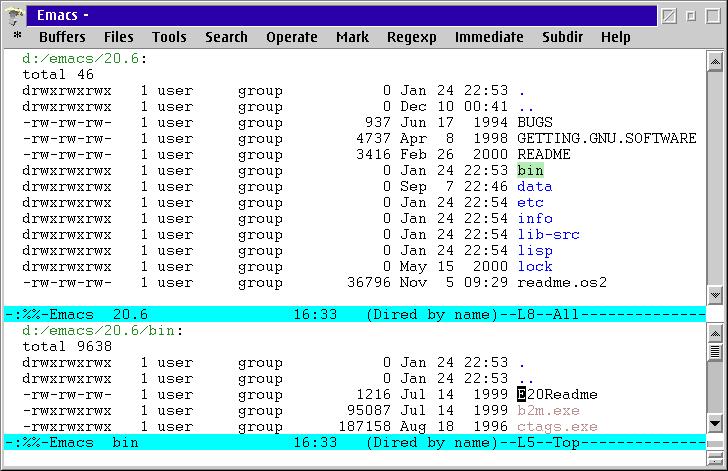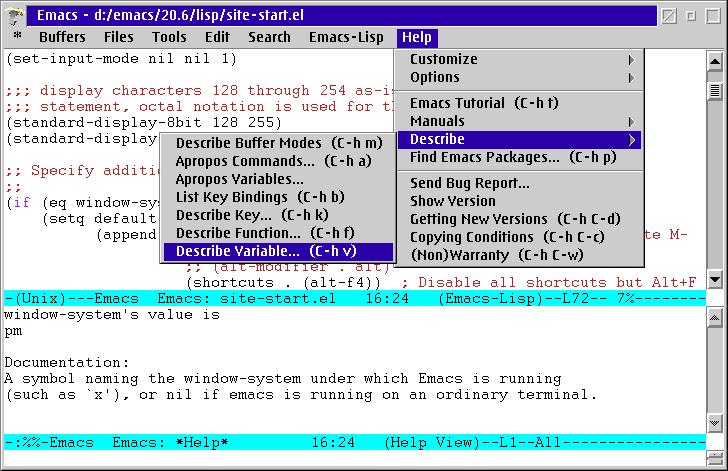 VOICE Home Page: http://www.os2voice.org |
[Previous Page] [Next Page] [Features Index] |
 VOICE Home Page: http://www.os2voice.org |
[Previous Page] [Next Page] [Features Index] |
I have been using Emacs under OS/2 for quite a while now. The last stable version
I have been using was the port of Eberhard Mattes, version 19.33. A year ago or
so, I tried to install the new port by Jeremy Bowen, version 20.3. I couldn't bring
it up as it should be, so I dropped the idea of upgrading my Emacs as the porting
enthusiasm has somehow ceased a bit. In November, 2000 Jeremy Bowen released version
20.6 of his OS/2 port and, as I was forced to install my whole working environment
anew after a bad disk crash, I decided to give it another try. I finally suceeded
in getting everything going like it should, and was even able to install packages
like e.g. mailcrypt which I had not been able to install under Emacs 19.33 for OS/2
for some reason.
In the long run it turned out that this new port behaves fairly stable on my computer as long as only internal features are being used. Interaction with other programs, e.g. sending mail, most often leads to exceptions (core dumps), if used repeatedly.
Thus I recommend to keep your old Emacs installation as a backup until you are really sure, this new port fits your needs. To interested new users in other words again: As long as you plan to use Emacs just for editing you are on the safe side. This port however is hardly usable as a mailer and such. If you would like to use Emacs heavily in interaction with other programs, you should consider to use Emacs 19.33.
The following will give you a general walkthrough for installing Emacs under
OS/2. However this is not meant to replace the existing readme files which come
with Emacs or additional packages.
![]() Whenever
you will see this icon the text following shows the problem(s) I ran into when installing
Emacs and some elisp packages and the workarounds and modifications I made to get
around the problems.
Whenever
you will see this icon the text following shows the problem(s) I ran into when installing
Emacs and some elisp packages and the workarounds and modifications I made to get
around the problems.
The distribution comes in four files e206base.zip, e206el1.zip,
e206elc.zip and e206rest.zip all of which amount to approximately
14 megabytes. It is necessary to download at least the first three of the files,
but I recommend downloading all four as the fourth one contains all the documentation
and manuals
I highly recommend that one download the gnuserv distribution (@Hobbes)
for OS/2 as this port of Emacs comes without an emacsclient.
You will also need approximately 50 megabytes free space on an HPFS drive for
the installation and UnZip
to unpack the files.
If you have never worked with the GNU/EMX environment under OS/2, you will also
need to download the EMX runtime files. The most recent version as of this writing
is EMX 0.9d, fix level 3. As Emacs itself can be retrieved from Hobbes (WWW,
FTP) or Leo (WWW,
FTP), make sure
your GNU/EMX environment is properly installed and up-to-date before you start to
install Emacs.
Additionally, you may want to install a Un*x compatible command line shell such
as the bash shell (@Leo)
or the korn shell (@Leo)
if you are planning to use Emacs in the full GNU/EMX environment. As far as I know
Emacs is able to work internally with the OS/2 shell cmd.exe, but I have
never tested this extensively. If you don't plan to use OS commands from within
Emacs anyhow, you don't need to care for now. You can install any shell later as
well.
Copy or move the four distribution files to the root directory of the drive where
you want to install Emacs. Emacs will be unzip'd into x:\emacs\20.6\ and
I highly recommend not to change the default paths.
Be sure to read the file readme.os2 in x:\emacs\20.6\.
2)
Put the following into your config.sys:
(Replace x: with the drive which matches your machine.) SET
PATH=[...];x:\emacs\20.6\bin;[...];
REM *** Emacs 20.6 ***
SET SHELL=x:/emx/bin/sh.exe
SET SYSTEMNAME=ohei
SET TMP=x:\tmp
SET TMPDIR=x:/tcpip/tmp
Also put the following lines into your config.sys if those are not already
in there from your GNU/EMX installation: SET TERM=ansi
SET TERMCAP=x:/emx/etc/termcap.dat
SET INFOPATH=x:/emx/info
SET HOME=x:/home
SET NAME=Oliver Heidelbach
SET USER=ohei
3)![]()
Basically you are done now. All of the above is standard procedure so far. However
I had to perform the following additional steps to keep everything happy (I guess
it has to do with some paths being left hard-coded in the port.):
4)
You should be done by now. Reboot your machine and change to the x:\emacs\20.6\bin
directory to dump Emacs with the batch file dump.cmd.
You may want to have a look at the instemacs.cmd file - call it without
any arguments to see what it can do for you.
5) - recommended
Create a directory x:\emacs\lisp. Put all additional elisp packages
and files into this directory. Thus you will always have the current Emacs distribution
separated from additional files you install. This will save you much time when you
are going to install the next version of Emacs.
Create a temporary directory or use one you already have for such purposes. Copy
the gnuserv distribution file os2_gnuserv_r3.zip to that directory and
unzip it. Copy or move the three *.exe files to the x:\emacs\20.6\bin
directory. Copy or move the file gnuserv.el to the x:\emacs\lisp
directory.
If you are planning to integrate the GNU Un*x style man pages into your environment,
copy or move the file gnuserv.1 to x:\emx\man\man1.
7) - optional
It is also a good idea to copy all the info documentation files into one standard
directory. That is probably x:\emx\info depending on where you have installed
GNU/EMX. Copy or move all the info files from x:\emacs\20.6\info to x:\emx\info\.
Don't copy/move the dir file as you would overwrite your current one. I
recommend to copy and paste the contents of the dir file which comes with
Emacs to the one residing in the GNU/EMX directory if the Emacs related entries
are missing from it.

Above: The directory structure of Emacs
Two files are of interest when it comes to setting up Emacs. One of those comes
with the default installation and is called site-start.el, to be found
in the x:\emacs\20.6\lisp directory. The other file is .emacs
that you will have to create in your home directory - the directory which you have
entered into the HOME environment variable in your config.sys.
Background information: Emacs originated in the Un*x platform which is a multi-user
environment. Thus there are two setup files, one for the whole site (site-start.el,
you have guessed it) and one for each single user, the .emacs file in the
user's home directory. These differences do not exist under OS/2. I personally tend
to use only site-start.el
under OS/2, having no .emacs file at all. However both files work as a
Emacs setup and both are valid with Emacs under OS/2.
Please note that there is no general setup other than the plain Emacs after the
installation. Everything else will probably differ more or less from user to user.
This also means that everything you add or change in the Emacs setup files also
changes the behaviour of Emacs. Please be aware of this fact when you have setup
questions and you already have changed the Emacs setup files.
Please note: Version 20.x of Emacs comes with a customization menu - see HELP
in the menu bar - with which you will be able to setup all Emacs packages/editing
modes etc. which support customization. The following steps will be a basic walkthrough:
setting up Emacs 20.6 under OS/2, addressing the problems I had setting all up,
and giving you some useful hints. However changing the setup via the customization
menu will not be addressed in the following.
Add the following to your site-start.el:
(setq load-path (append '("x:/emacs/lisp/")
Emacs 20.6 comes without TAGS files which means you will have to build
those files yourself. This is done with the program etags which resides
in the x:\emacs\20.6\bin directory.
![]()
When I tried to do just that, I always got an error message and nothing happened.
When I used the etags program from the Emacs 19.33 distribution I was able
to build all the TAGS files instantly.
However I still could not use context-sensitive help from within Emacs as everytime
I typed [C-h v] or [C-h f] I got another error message related
to the file fns-20.6.1.el in the x:\emacs\20.6\bin. It turned
out that this files contains garbage at the very end. To solve the problem load
it into Emacs and delete all the garbage.
The file should end with
... dont-compile eval-when-compile eval-and-compile)
)))
You now have context-sensitive help available.

Above: Context-sensitive help in Emacs
Download a working etags
program. Put the files into the X:\emacs\20.6\bin directory. For your
convenience the program includes a batch file makeetags.cmcl which will loop
through all standard elisp directories to build the TAGS files. You must
call this batch file from within the x:\emacs\20.6\bin for it to work properly.
If you have installed Gnuserv, add the following to your
site-start.el:
Also by default Emacs does know about your screen resolution. You may want to
blow up the size of the Emacs window to fit a 1024*768 screen resolution.
You also may want to set another menu font for Emacs.
Try the following:
Try to experiment with the window size and fonts until you are satisfied. As
you may have already guessed, a semicolon does comment out the following code.
Add the following to your site-start.el and change it according to your
environment:
![]() The readme.os2
files says rmail would work now. It did not for me and it gave me a hard time setting
it up.
The readme.os2
files says rmail would work now. It did not for me and it gave me a hard time setting
it up.
If your local pop3 mailbox is in Un*x format everything seems to be fine, but
if you are using the lamailer format, retrieving mail from the local mailbox seems
not to work. I always got the error message "Cannot convert to babyl format"
when I tried to load the new mail with rmail. The problem is the movemail program
which is distributed with Emacs and can be found in the x:\emacs\20.6\bin
directory. After trying nearly every available pop3 mail retrieving program available
for OS/2, I installed the old movemail
program which is distributed with Emacs version 19.33 and the problem dissappeared
immediately.
Install the executable files in x:\emacs\20.6\bin.
Also be sure to add to following (change to fit your environment):
Please see my site-start.el for a more complete setup of the mail/rmail environment.
You should now have managed all the odds and ends of the basic installation of
version 20.6.1 of Emacs for OS/2.
Part II of this walkthrough will deal with setting up some additional elisp packages
like mailcrypt and bbdb. It will also deal with setting up a Mule independent ISO-8859-1
environment for mail and editing.